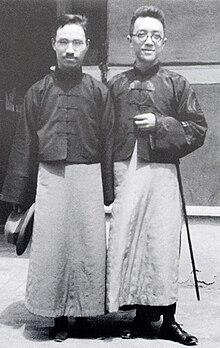Hu Xiansu
Hu Xiansu ( Chinese 胡先 驌 / 胡先 骕 , Pinyin Hú Xiānsù , W.-G. Hu Hsien-Su , born May 24, 1894 in Nanchang , Jiangxi Province ; † July 16, 1968 in Beijing ) was a Chinese botanist , educator and cultural scientist . He was the founding father of the botanical taxonomy of China and - together with Qian Chongshu - pioneer of modern Chinese botany . In addition, he was also one of the founders of modern biology in China. In botanical literature he is mostly quoted with the name Hsen-Hsu Hu . Its official botanical author's abbreviation is " Hu ".
In the early 1920s, together with Mei Guangdi , he founded the humanities journal Xueheng (学 衡The Critical Review ), which was dedicated to the protection and defense of the culture of China and contributed to the development of the Guoxue (国学), i.e. one on pre-classical China, in particular Confucianism concentrated humanities. He disapproved of the high regard for Western culture as represented by Hu Shi and others.
In the early 1950s, Hu Xiansu publicly criticized Lyssenko's theory , which was then widespread in the Soviet Union , that acquired traits are inherited. Together with Tan Jiazhen , he represented the development of a genetics- based hereditary teaching according to Mendel - Morgan rules. Since Soviet dogmas were binding on Chinese scientists at that time, Hu Xiansu was sharply criticized politically for it.
Live and act
Hu Xiansu was born on May 24, 1894 in Nanchang, Jiangxi Province. From 1909 to 1913 he completed the preparatory course at Jingshi Daxue Tang (京师 大 学堂), which later became Beijing University . It followed from 1913 to 1916 the study with a BA degree in the forestry faculty of the College of Agriculture at the University of California, Berkeley .
From 1916 to 1918 he was deputy head of the Lushan Forestry Department in Jiangxi Province . From 1918 to 1923 Hu Xiansu was professor of agricultural sciences and dean of the biological faculty at the Nanjing University of Education ( Nanjing Gaodeng Shifan Xuexiao南京 高等 师范学校), from 1921 State University of the Southeast ( Guoli Dongnan Daxue国立 东南大学), later Nanjing University (南京大学).
He then studied at Harvard University (1923 to 1925) with degrees MA and Ph. D. in botanical taxonomy.
At Nanjing University ("State University of the Southeast") he was professor from 1925 to 1928 and head of the botanical department of the Biological Institute of the "Scientific Society of China" (中国 科学 社).
In 1928 he founded the “Jingsheng Research Institute for Biology” (静 生 生物 调查 所), the forerunner of the zoological and botanical research institutes of Academia Sinica ( 中国科学院), in Beijing together with the Manjurian zoologist Bing Zhi . The name Jingsheng stood for the famous teacher and early promoter of biological sciences Fan Yuanlian (范 源 濂, 1876-1927), whose zì name was Fan Jingsheng. From 1928 to 1932 he was also head of the botanical department of the "Jingsheng Research Institute for Biology", at the same time professor at the biological faculties of Peking University and the Beijing Pedagogical University . From 1932 to 1940, Hu Xiansu was director of the "Jingsheng Research Institute for Biology". During this time he continued the two biology professorships mentioned above at the major Beijing universities and participated in the creation of the "Botanical Society of China" (中国 植物 学会). Around the same time, the "Botanical Forest Garden" was founded in Lushan and the "Research Institute for Botany of Agricultural and Forestry Sciences Yunnan ", the forerunner of today's Kunming Botanical Research Institute of Academia Sinica (中国科学院 昆明 植物 研究所).
From 1940 to 1944 he was the founding rector of Zhongzheng University (中正 大学), later Nanchang University (南昌 大学). From 1946 to 1949 he held the post of director of the "Jingsheng Research Institute of Biology".
In 1946, together with Professor Zheng Wanjun from the National Central University ( Guoli Zhongyang Daxue国立 中央 大学), he discovered and named the living fossil Shuishan (水杉), the primeval sequoia ( Metasequoia glyptostroboides ) from the cypress family (Cupressaceae) . The site was in the then district Wan (万县) the province of Sichuan , today District Wanzhou (万州区) of the centrally-administered city of Chongqing .
From 1950 to 1968, Hu Xiansu was Science Councilor (with the rank of professor) at the Research Institutes for Botanical Taxonomy and for Botany at Academia Sinica.
He died on July 16, 1968 in Beijing .
Honors
The genus Huodendron Rehder from the Storax tree family (Styracaceae) and Huthamnus Tsiang from the dog poison family (Apocynaceae) is named after Hu .
Works
- Icones filicum sinicarum (together with R.-C. Ching), 1930
- Icones plantarum sinicarum (together with Woon-Young Chun), 1927–1937
Web links
- Brief biography of Hu Xiansu in Chinese
- Review of a book on Hu Xiansu
- Author entry and list of the described plant names for Hu Xiansu at the IPNI
Single receipts
- ^ Judith Shapiro: Mao's war against nature - Politics and the Environment in Revolutionary China . Cambridge University Press, Cambridge 2001, ISBN 978-0521786805 , p. 26
- ↑ Lotte Burkhardt: Directory of eponymous plant names . Extended Edition. Botanic Garden and Botanical Museum Berlin, Free University Berlin Berlin 2018. [1]
| personal data | |
|---|---|
| SURNAME | Hu Xiansu |
| ALTERNATIVE NAMES | Hsen-Hsu Hu |
| BRIEF DESCRIPTION | Chinese botanist, educator and cultural scientist |
| DATE OF BIRTH | May 24, 1894 |
| PLACE OF BIRTH | Nanchang , Jiangxi Province |
| DATE OF DEATH | July 16, 1968 |
| Place of death | Beijing |
